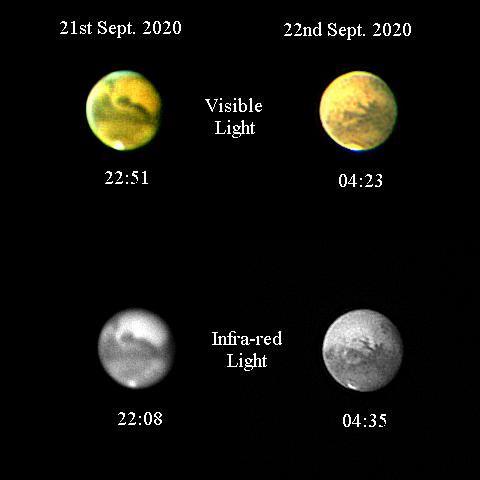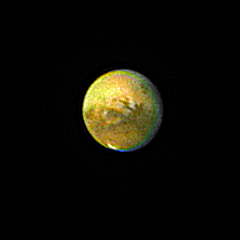Mars in 2020 
Mars reaches opposition on 13 October 2020.
The simulations are from Calsky and show Mars as it was expected to be seen through a 10-inch telescope at the date and time indicated. These simulations are all on the same scale and do not reflect the changing apparent size of the planet as its distance from us changes. My images do reflect that change and can most easily be seen on my page for the 2005/6 season. The orientation of the simulated image and my image may not be the same.
I was very lucky in the night of 21-22 September 2020. I was expecting the skies to cloud over before midnight and indeed they did seem to be deteriorating by 23:00 GMT. However when I woke about 04:00 the next morning there was Mars shining brightly. I had left everything set up from earlier so tried again. This picture shows pictures in both visible light and in infra-red at the times shown, about 5½ hours apart.

|
Date and Time: 21-22 September 2020 at times indicated
Camera: DFK 21AF04 (colour) and DMK 21AF04 (monochrome)
Telescope: LX200 with X2 SLR lens and, for the IR image, an IR-pass filter (>652 nm)
Capture: IC Capture. Colour 1/154" and 1/183", gain 1023,
frames collected 3551 and 3586 .
Monochrome 1/154", gain 1023 and 939,
frames collected 3586 and 3600
Processing: Registax 5. 400 to 600 frames stacked, colour alignment, wavelets 1-2=20, histogram stretch as appropriate.
|
I took the infra-red image at 04:35 and coloured it with the image from 04:23 using the LRGB technique. The result is shown on the left below. On the right is a simulation of how Mars should look through a 10-inch telescope taken from Calsky.
 |
Date and Time: 22 September 2020 04:35 UT
Camera: DMK 21AF04
Telescope: LX200 with X2 SLR lens and IR-pass filter (>652 nm)
Capture: IC Capture. 1/154", gain 939, frames 3600
Processing: Registax 5. 347 frames stacked, wavelets 1-2=20, histogram 0-230
Focus Magic 3
|
 |
Sadly CalSky has gone, so I am no longer able to show a simulation of how Mars should look.

| Three images of Mars; the first in colour, the second in infra-red, and the third is the IR image coloured with the colour image by the LRGB technique. I have captured Nix Olympica, the white spot in the north (about 1 o'clock in my image). We now know that this is a huge shield volcano and has been renamed Olympus Mons. The old name means Snows of Olympus. On looking back I see that I also caught it in the IR images in 2005.
Date and Time: 15 October 2020 22:30 to 22:40 UT
Camera: DMK 21AF04 (IR image) and DFK 21AF04 (Colour image)
Telescope: LX200 with X2 SLR lens with and without IR-pass filter (>652 nm)
Capture: IC Capture. IR image, 1/367", gain 1023, frames 1800
Colour image 1/308". gain 1023, frames 1800
Processing: Registax 6.
IR image, 599 frames stacked, wavelets 1-2=20, histogram 0-200, Focus Magic 4
Colour image, 945 frames stacked, wavelets 1-2=20,
histogram 0-215
|
Home Back to Mars





